How to Read a Random Csv R
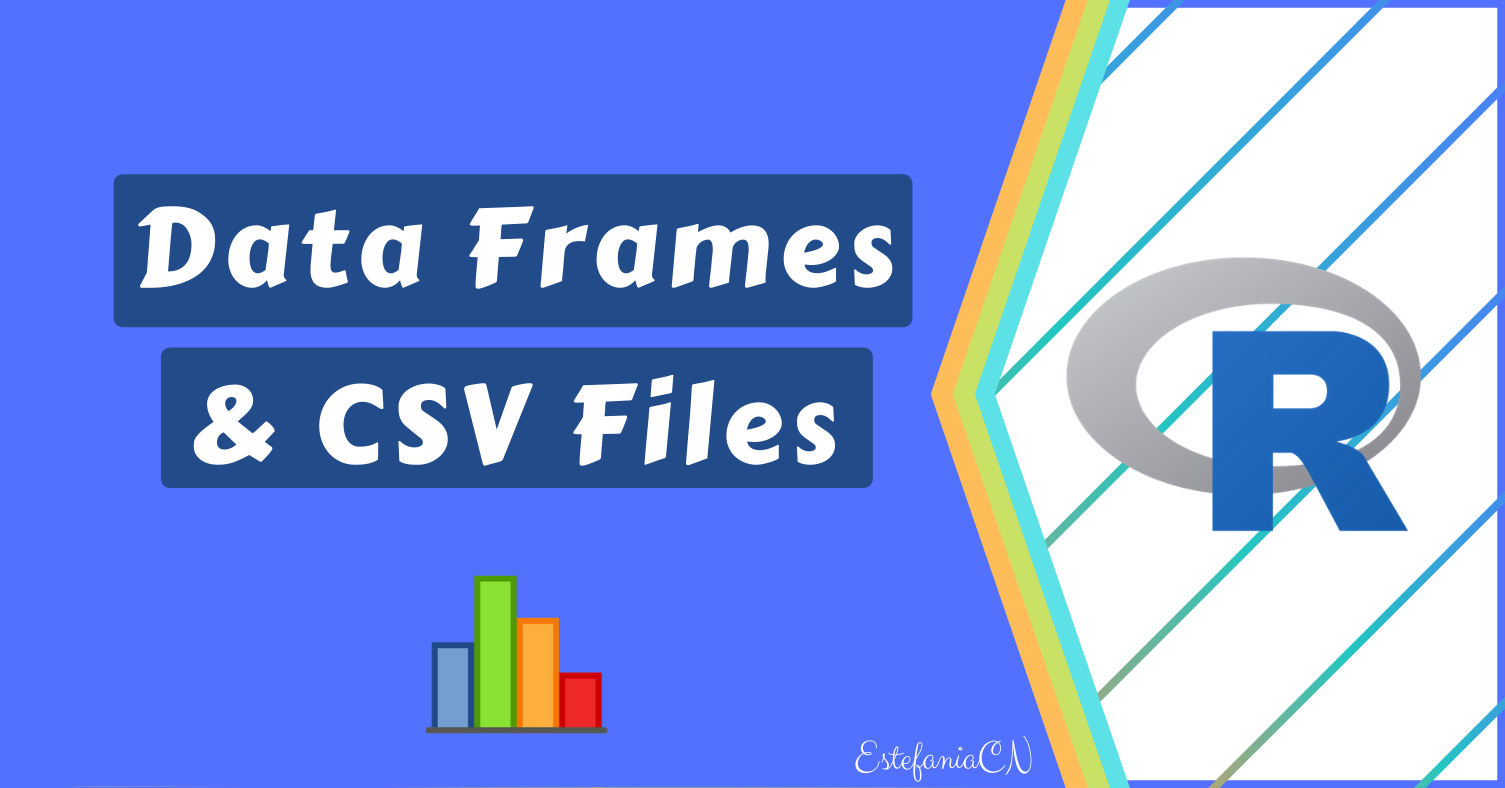
Welcome! If you want to start diving into information science and statistics, then data frames, CSV files, and R will be essential tools for you. Let's encounter how yous tin use their astonishing capabilities.
In this commodity, you lot will larn:
- What CSV files are and what they are used for.
- How to create CSV files using Google Sheets.
- How to read CSV files in R.
- What Information Frames are and what they are used for.
- How to access the elements of a data frame.
- How to modify a data frame.
- How to add and delete rows and columns.
We will utilise RStudio, an open-source IDE (Integrated Development Environment) to run the examples.
Let's begin! ✨
🔹 Introduction to CSV Files
CSV (Comma-separated Values) files can be considered ane of the building blocks of data assay because they are used to shop data represented in the course of a table.
In this file, values are separated past commas to correspond the different columns of the table, like in this example:

We will generate this file using Google Sheets.
🔸 How to Create a CSV File Using Google Sheets
Let's create your showtime CSV file using Google Sheets.
Pace one: Get to the Google Sheets Website and click on "Go to Google Sheets":
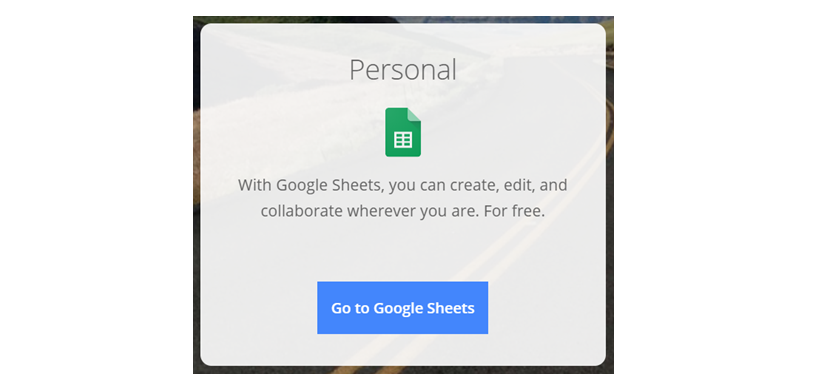
💡 Tip: You tin can access Google Sheets by clicking on the button located at the height-right edge of Google's Home Page:
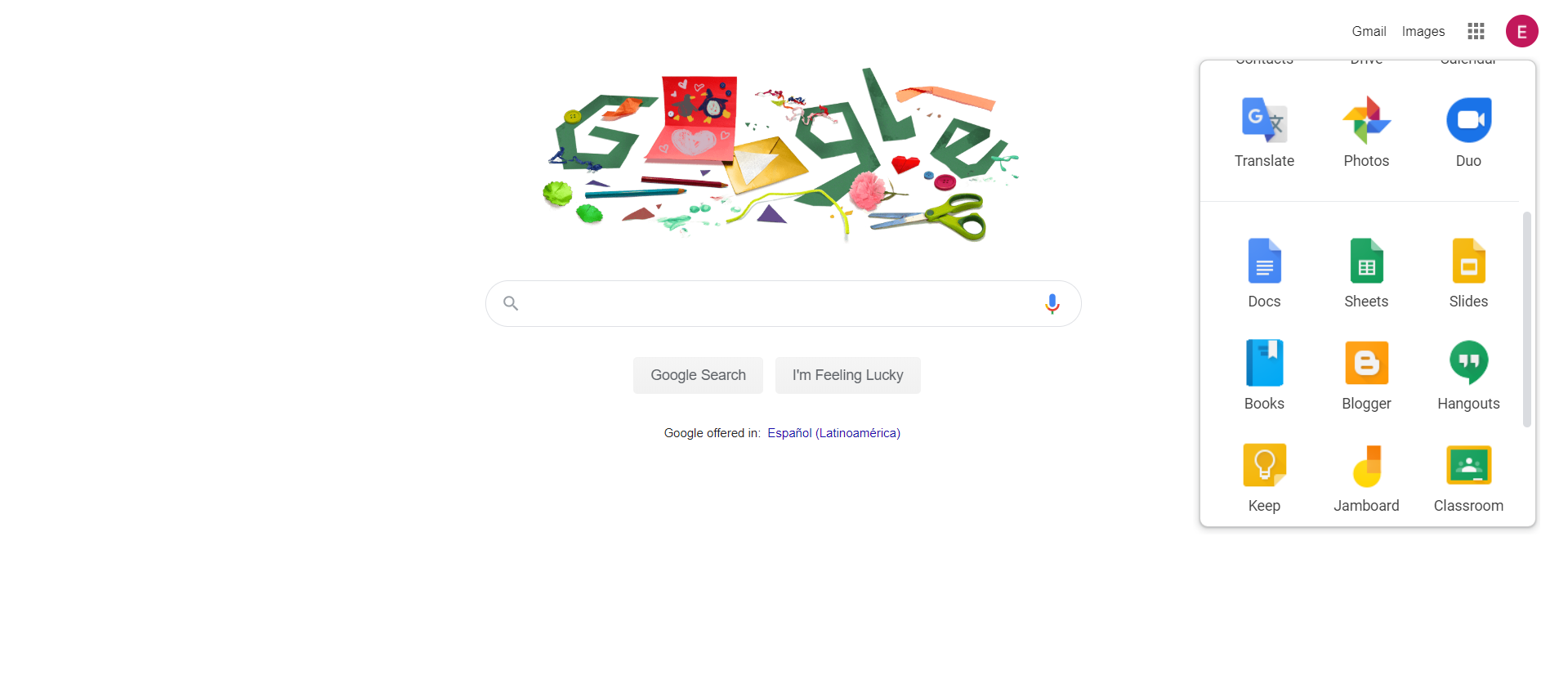
If nosotros zoom in, nosotros come across the "Sheets" button:
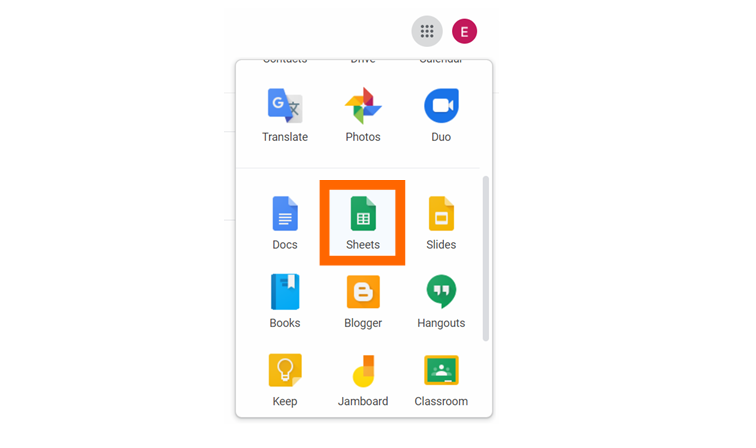
💡 Tip: To use Google Sheets, you demand to take a Gmail account. Alternatively, you tin create a CSV file using MS Excel or some other spreadsheet editor.
You will see this panel:
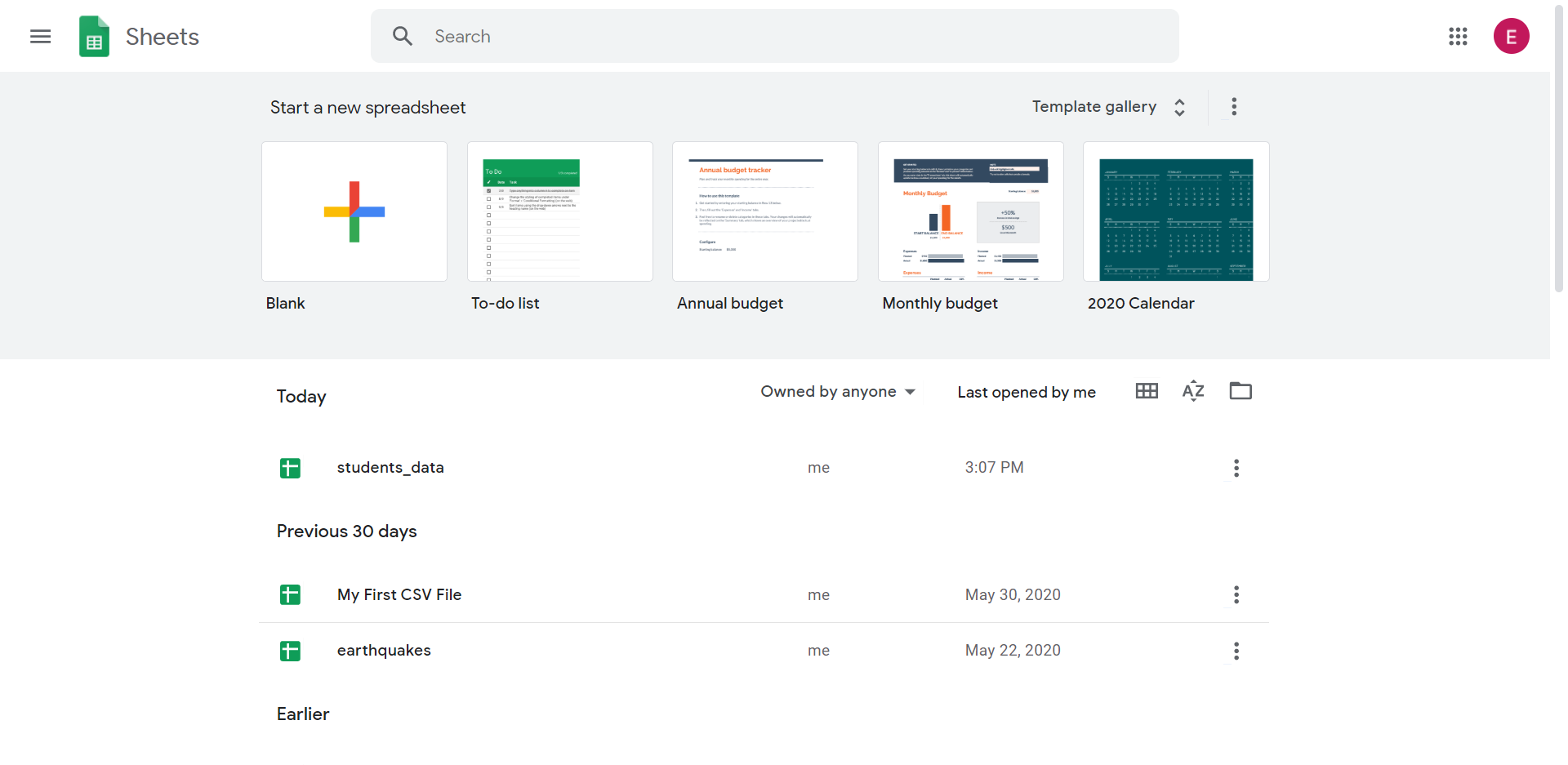
Step 2: Create a blank spreadsheet by clicking on the "+" button.
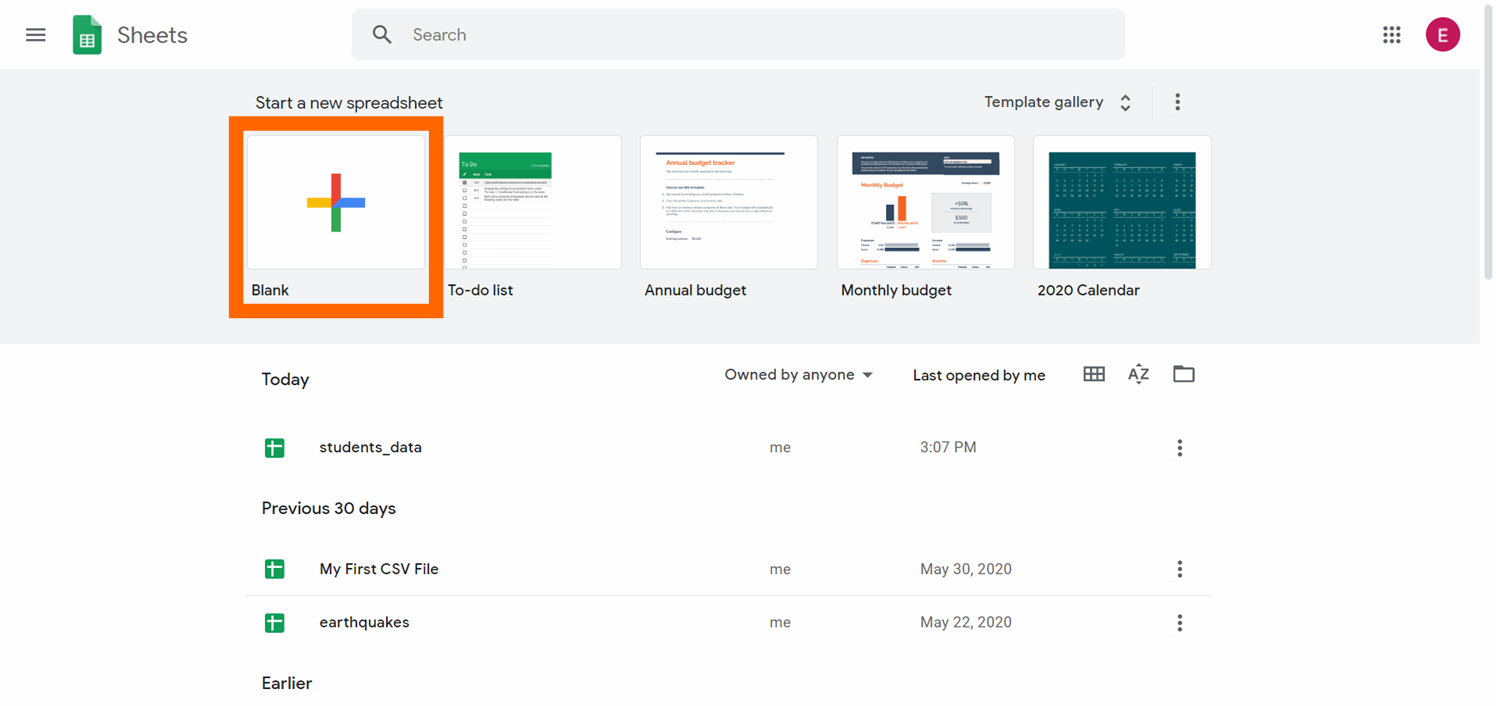
Now y'all take a new empty spreadsheet:

Step iii: Alter the name of the spreadsheet to students_data. We volition need to use the name of the file to work with data frames. Write the new name and click enter to confirm the change.

Footstep 4: In the get-go row of the spreadsheet, write the titles of the columns.
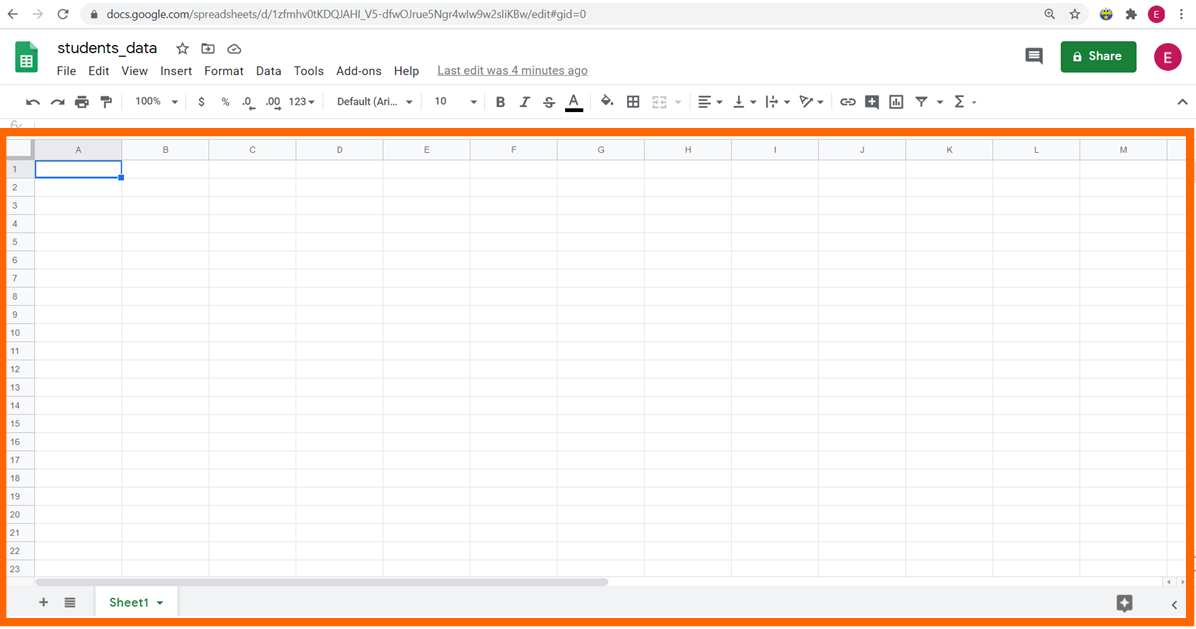
When you import a CSV file in R, the titles of the columns are called variables. We will define 6 variables: first_name, last_name, historic period, num_siblings, num_pets, and eye_color, as you can see right here beneath:

💡 Tip: Notice that the names are written in lowercase and words are separated with an underscore. This is not mandatory, but since y'all will demand to access these names in R, it'due south very mutual to use this format.
Step 5: Enter the data for each one of the columns.
When y'all read the file in R, each row is chosen an observation, and information technology corresponds to data taken from an individual, animal, object, or entity that we collected information from.
In this example, each row corresponds to the information of a pupil:
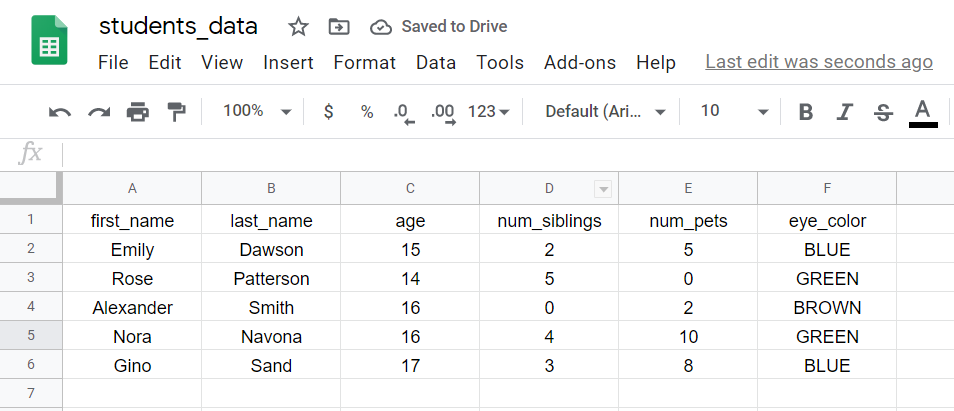
Step six: Download the CSV file by clicking on File -> Download -> Comma-separated values, as you lot tin meet below:

Step 7: Rename the file CSV file. You will need to remove "Sheet1" from the default proper noun considering Google Sheet will automatically add this to the name of the file.

Great work! At present you lot take your CSV file and it's time to starting time working with it in R.
🔹 How to Read a CSV file in R
In RStudio, the get-go step before reading a CSV file is making sure that your current working directory is the directory where the CSV file is located.
💡 Tip: If this is not the instance, you lot will need to apply the total path to the file.
Change Current Working Directory
Y'all can modify your current working directory in this panel:

If we zoom in, you tin can see the current path (1) and select the new ane past clicking on the ellipsis (...) button to the right (2):

💡 Tip: You can likewise check your electric current working directory with getwd() in the interactive console.
Then, click "More" and "Prepare Equally Working Directory".

Read the CSV File
One time you lot have your current working directory set up, y'all can read the CSV file with this command:
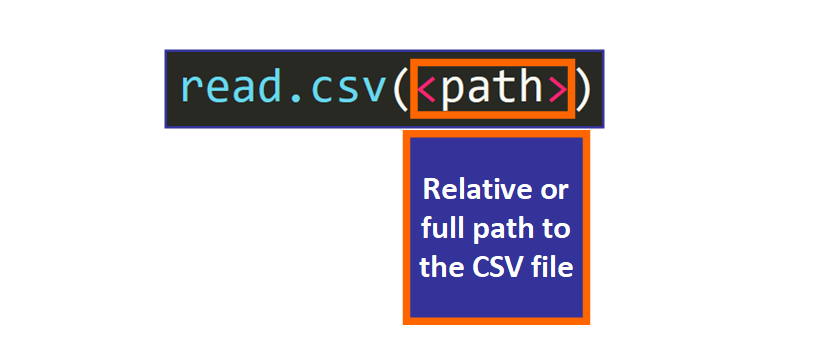
In R lawmaking, we have this:
> students_data <- read.csv("students_data.csv") 💡 Tip: We assign it to the variable students_data to access the information of the CSV file with this variable. In R, we tin can separate words using dots ., underscores _, UpperCamelCase, or lowerCamelCase.
After running this command, you volition run into this in the pinnacle right console:
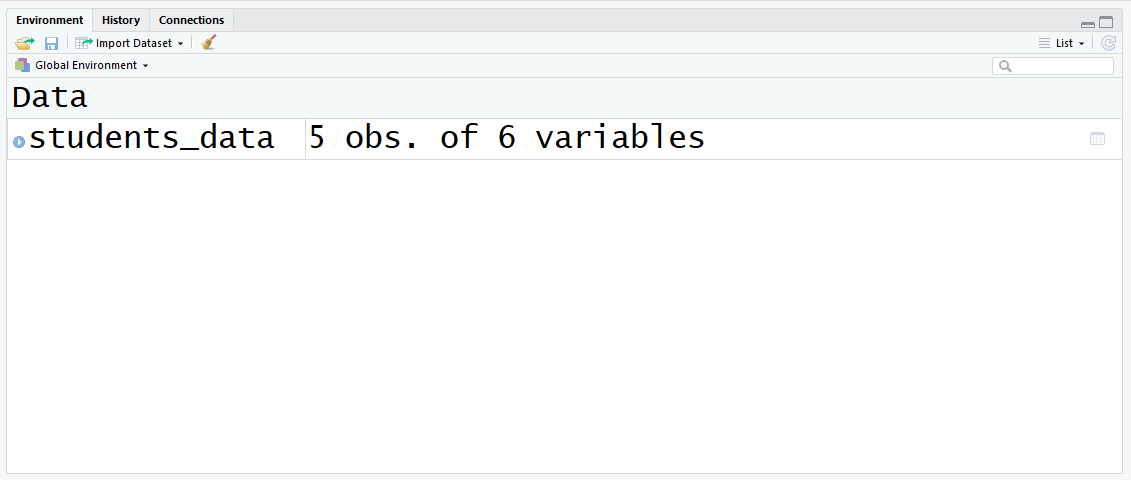
Now y'all take a variable defined in the environs! Let's run into what data frames are and how they are closely related to CSV files.
🔸 Introduction to Data Frames
Information frames are the standard digital format used to store statistical information in the grade of a table. When you read a CSV file in R, a data frame is generated.
We can confirm this past checking the type of the variable with the class function:
> form(students_data) [1] "data.frame" It makes sense, right? CSV files contain information represented in the form of a table and information frames correspond that tabular data in your lawmaking, and so they are deeply connected.
If you enter this variable in the interactive console, you will see the content of the CSV file:
> students_data first_name last_name age num_siblings num_pets eye_color i Emily Dawson xv 2 5 Blue 2 Rose Patterson fourteen 5 0 GREEN three Alexander Smith 16 0 2 Chocolate-brown 4 Nora Navona sixteen 4 10 Light-green five Gino Sand 17 3 8 Blueish More than Information About the Information Frame
You take several different alternatives to see the number of variables and observations of the data frame:
- Your first choice is to look at the meridian correct panel that shows the variables that are currently defined in the environment. This data frame has 5 observations (rows) and 6 variables (columns):

- Another alternative is to use the functions
nrowandncolin the interactive panel or in your program, passing the data frame as argument. We get the aforementioned results: 5 rows and 6 columns.
> nrow(students_data) [i] 5 > ncol(students_data) [1] 6 - You tin also see more information about the data frame using the
strfunction:
> str(students_data) 'data.frame': 5 obs. of vi variables: $ first_name : Factor w/ 5 levels "Alexander","Emily",..: two 5 i 4 3 $ last_name : Cistron w/ v levels "Dawson","Navona",..: 1 3 5 2 4 $ historic period : int 15 xiv 16 16 17 $ num_siblings: int ii 5 0 4 3 $ num_pets : int 5 0 2 x eight $ eye_color : Cistron due west/ 3 levels "BLUE","BROWN",..: i 3 two three one This function (practical to a data frame) tells y'all:
- The number of observations (rows).
- The number of variables (columns).
- The names of the variables.
- The data types of the variables.
- More information nearly the variables.
Y'all tin meet that this function is really great when you want to know more nearly the data that y'all are working with.
💡 Tip: In R, a "Factor" is a qualitative variable, which is a variable whose values represent categories. For example, eye_color has the values "BLUE", "BROWN", "Green" which are categories, and then as yous tin see in the output of str in a higher place, this variable is automatically divers as a "cistron" when the CSV file is read in R.
🔹 Data Frames: Key Operations and Functions
Now you know how to see more data about the information frame. But the magic of data frames lies in the amazing capabilities and functionality that they offer, so let'south run across this in more item.
How to Access A Value of a Data Frame
Information frames are like matrices, so you can access individual values using 2 indices surrounded past square brackets and separated past a comma to signal which rows and which columns yous would similar to include in the result, like this:

For case, if we want to access the value of eye_color (column six) of the fourth student in the information (row 4):

Nosotros need to use this command:
> students_data[iv, half dozen] 💡 Tip: In R, indices start at 1 and the first row with the names of the variables is non counted.
This is the output:
[1] Green Levels: Blue BROWN GREEN You lot tin can run across that the value is "Greenish". Variables of type "gene" have "levels" that represent the different categories or values that they can take. This output tells u.s. the levels of the variable eye_color.
How to Access Rows and Columns of a Data Frame
Nosotros can besides use this syntax to admission a range of rows and columns to get a portion of the original matrix, like this:
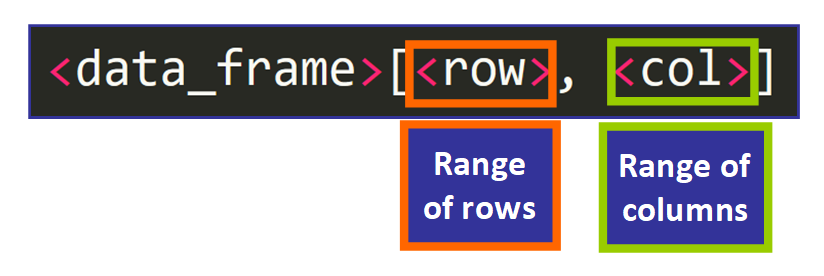
For example, if we want to get the historic period and number of siblings of the third, fourth, and fifth student in the listing, we would use:
> students_data[iii:v, iii:4] age num_siblings iii xvi 0 4 16 4 v 17 3 💡 Tip: The basic syntax to define an interval in R is <get-go>:<end>. Note that these indices are inclusive, so the third and fifth elements are included in the case above when we write three:5.
If we want to get all the rows or columns, we only omit the interval and include the comma, like this:
> students_data[3:5,] first_name last_name historic period num_siblings num_pets eye_color 3 Alexander Smith xvi 0 2 BROWN 4 Nora Navona 16 4 ten GREEN five Gino Sand 17 3 8 Blueish Nosotros did not include an interval for the columns after the comma in students_data[3:5,], so nosotros go all the columns of the information frame for the 3 rows that we specified.
Similarly, we tin can get all the rows for a specific range of columns if we omit the rows:
> students_data[, 1:3] first_name last_name historic period one Emily Dawson xv ii Rose Patterson 14 3 Alexander Smith 16 4 Nora Navona 16 5 Gino Sand 17 💡 Tip: Notice that you all the same demand to include the comma in both cases.
How to Access a Column
There are three ways to access an entire column:
- Option #1: to access a column and return information technology as a data frame, you can apply this syntax:

For example:
> students_data["first_name"] first_name 1 Emily 2 Rose three Alexander 4 Nora v Gino - Option #2: to go a column as a vector (sequence), you can utilize this syntax:

💡 Tip: Notice the apply of the $ symbol.
For example:
> students_data$first_name [1] Emily Rose Alexander Nora Gino Levels: Alexander Emily Gino Nora Rose - Choice #iii: You can also use this syntax to get the cavalcade every bit a vector (run across beneath). This is equivalent to the previous syntax:
> students_data[["first_name"]] [1] Emily Rose Alexander Nora Gino Levels: Alexander Emily Gino Nora Rose How to Filter Rows of a Data Frame
You tin can filter the rows of a data frame to become a portion of the matrix that meets certain conditions.
For this, nosotros utilize this syntax, passing the condition as the first element inside square brackets, so a comma, and finally leaving the second element empty.

For example, to get all rows for which students_data$historic period > sixteen, we would use:
> students_data[students_data$age > xvi,] first_name last_name age num_siblings num_pets eye_color 5 Gino Sand 17 3 8 Blueish We get a data frame with the rows that run into this condition.
Filter Rows and Cull Columns
You can combine this condition with a range of columns:
> students_data[students_data$age > 16, iii:6] historic period num_siblings num_pets eye_color five 17 3 8 Blueish We go the rows that run across the condition and the columns in the range iii:6.
🔸 How to Change Data Frames
You tin modify private values of a data frame, add columns, add together rows, and remove them. Allow's run into how you lot can do this!
How to Modify A Value
To alter an individual value of the information frame, you lot demand to use this syntax:

For example, if nosotros want to modify the value that is currently at row 4 and column six, denoted in blue right hither:

We need to use this line of code:
students_data[4, 6] <- "Chocolate-brown" 💡 Tip: You lot can also use = as the assignment operator.
This is the output. The value was inverse successfully.

💡 Tip: Call up that the first row of the CSV file is non counted as the beginning row because it has the names of the variables.
How to Add together Rows to a Data Frame
To add a row to a data frame, y'all need to use the rbind function:

This function takes two arguments:
- The data frame that you desire to modify.
- A list with the data of the new row. To create the listing, you lot can use the
list()function with each value separated by a comma.
This is an example:
> rbind(students_data, list("William", "Smith", fourteen, 7, 3, "Brownish")) The output is:
first_name last_name historic period num_siblings num_pets eye_color one Emily Dawson 15 2 5 BLUE 2 Rose Patterson 14 5 0 Dark-green 3 Alexander Smith sixteen 0 2 Dark-brown 4 Nora Navona 16 4 10 Dark-brown five Gino Sand 17 3 8 Bluish six <NA> Smith 14 7 three BROWN But wait! A warning message was displayed:
Warning message: In `[<-.factor`(`*tmp*`, ri, value = "William") : invalid factor level, NA generated And observe the first value of the sixth row, it is <NA>:
half-dozen <NA> Smith 14 vii 3 BROWN This occurred because the variable first_name was defined automatically as a factor when nosotros read the CSV file and factors have fixed "categories" (levels).
You lot cannot add a new level (value - "William") to this variable unless you lot read the CSV file with the value FALSE for the parameter stringsAsFactors, as shown below:
> students_data <- read.csv("students_data.csv", stringsAsFactors = FALSE) 
Now, if we effort to add together this row, the data frame is modified successfully.
> students_data <- rbind(students_data, listing("William", "Smith", 14, vii, iii, "BROWN")) > students_data first_name last_name age num_siblings num_pets eye_color ane Emily Dawson 15 ii 5 Bluish 2 Rose Patterson 14 5 0 GREEN 3 Alexander Smith 16 0 ii BROWN 4 Nora Navona 16 four 10 GREEN 5 Gino Sand 17 iii 8 Bluish vi William Smith 14 7 3 BROWN 💡 Tip: Note that if you read the CSV file again and assign it to the aforementioned variable, all the changes fabricated previously will be removed and y'all will see the original information frame. You need to add this argument to the beginning line of code that reads the CSV file and then make changes to it.
How to Add Columns to a Information Frame
Adding columns to a information frame is much simpler. You lot need to use this syntax:

For instance:
> students_data$GPA <- c(four.0, 3.five, 3.2, 3.15, 2.9, three.0) 💡 Tip: The number of elements has to exist equal to the number of rows of the data frame.
The output shows the data frame with the new GPA cavalcade:
> students_data first_name last_name age num_siblings num_pets eye_color GPA 1 Emily Dawson 15 2 5 Blue 4.00 2 Rose Patterson 14 5 0 GREEN 3.l 3 Alexander Smith 16 0 2 BROWN 3.20 4 Nora Navona 16 four ten GREEN 3.15 v Gino Sand 17 iii eight Blueish 2.ninety half dozen William Smith 14 7 3 BROWN 3.00 How to Remove Columns
To remove columns from a data frame, you demand to utilize this syntax:

When you assign the value Naught to a cavalcade, that column is removed from the data frame automatically.
For example, to remove the age cavalcade, we apply:
> students_data$age <- Naught The output is:
> students_data first_name last_name num_siblings num_pets eye_color GPA 1 Emily Dawson ii v BLUE iv.00 ii Rose Patterson five 0 GREEN 3.l 3 Alexander Smith 0 2 BROWN 3.20 4 Nora Navona 4 10 GREEN 3.fifteen 5 Gino Sand 3 8 Blue two.xc 6 William Smith 7 3 BROWN 3.00 How to Remove Rows
To remove rows from a information frame, you can utilise indices and ranges. For example, to remove the offset row of a data frame:

The [-i,] takes a portion of the information frame that doesn't include the first row. And then, this portion is assigned to the aforementioned variable.
If we take this information frame and we want to delete the start row:

The output is a data frame that doesn't include the commencement row:

In general, to remove a specific row, y'all need to employ this syntax where <row_num> is the row that you desire to remove:

💡 Tip: Notice the - sign earlier the row number.
For example, if we want to remove row 4 from this data frame:

The output is:

As you can see, row 4 was successfully removed.
🔹 In Summary
- CSV files are Comma-Separated Values Files used to represent data in the form of a tabular array. These files tin can exist read using R and RStudio.
- Information frames are used in R to represent tabular data. When you read a CSV file, a data frame is created to shop the data.
- You tin access and alter the values, rows, and columns of a information frame.
I really hope that you liked my article and found it helpful. Now you can work with information frames and CSV files in R.
If yous liked this article, consider enrolling in my new online course "Introduction to Statistics in R - A Practical Arroyo "
Larn to code for free. freeCodeCamp's open up source curriculum has helped more than 40,000 people get jobs as developers. Get started
Source: https://www.freecodecamp.org/news/how-to-work-with-data-frames-and-csv-files-in-r/
Postar um comentário for "How to Read a Random Csv R"